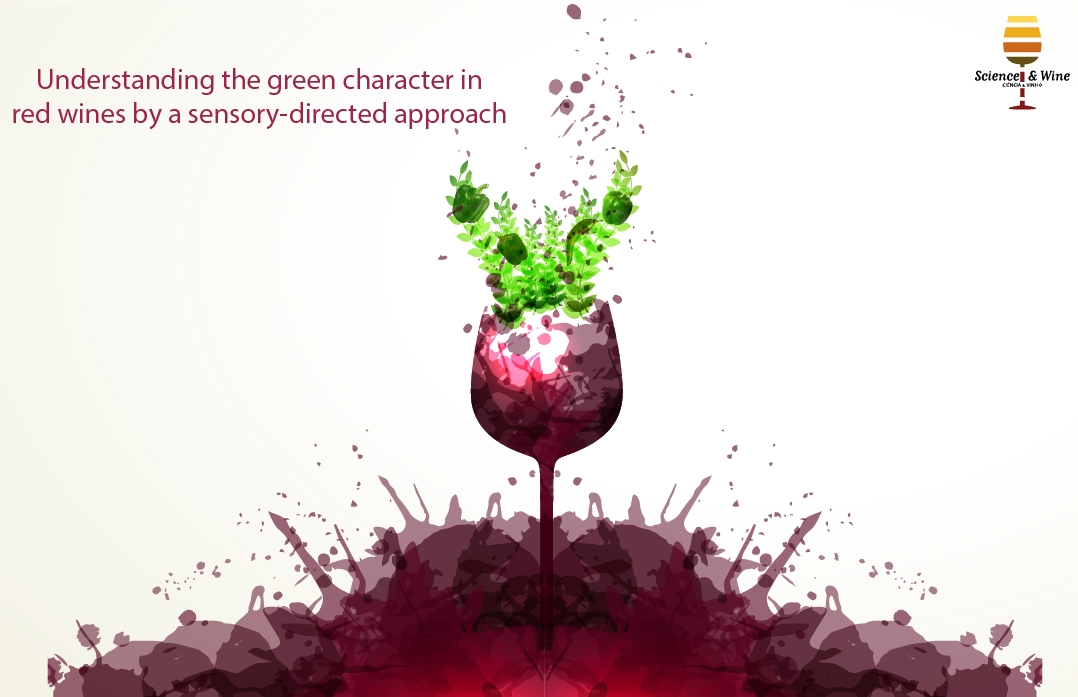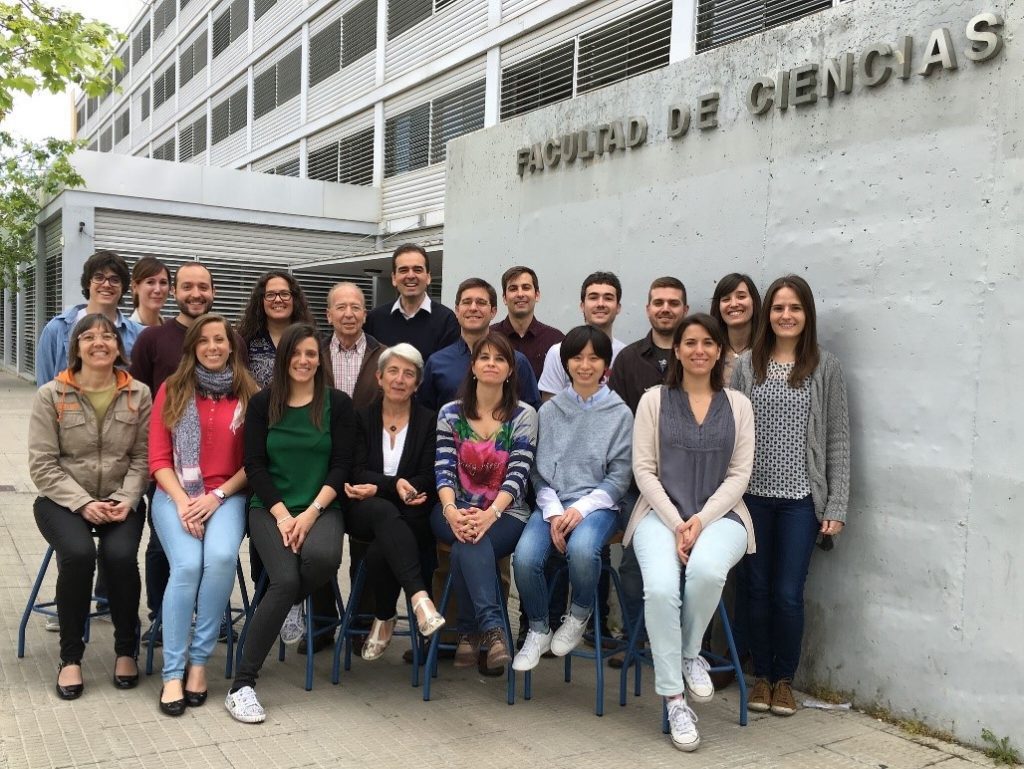By Sara Ferrero del Teso, María-Pilar Sáenz Navajas, Ignacio Arias Pérez, Purificación Fernández Zurbano, Ana Escudero, Vicente Ferreira
Flavour in food and beverages is the result of sensory interactions between sensory active volatile and non-volatile molecules (Prescott, 2012). An increase, in knowledge about flavour formation would allow to have objective tools to manage the production process and optimise the quality of the final product. The chromatographic separation of volatile and non-volatile compounds or group of compounds followed by sensory description of fractions is a common strategy that flavourists use to identify sensory-active molecules related to both aroma and taste or mouth-feel properties (Sáenz-Navajas et al., 2017; Scharbert, Holzmann, & Hofmann, 2004).
Nevertheless, the study of the sensory activity of non-volatile molecules is less explored than volatiles. The absence of reference materials with defined mouthfeel properties, makes it difficult to progress in finding the chemical compound or group of compounds responsible for such properties in complex foods or beverages such as wine. Furthermore, the study of the sensory activity of non-volatile molecules, takes more time and resource consuming especially due to sensory fatiguing induced by in-mouth tasting in comparison with orthonasal olfaction needed to evaluate aroma-related molecules.
The presented work has applied the flavourist strategy of separating both volatile and non-volatile molecules, to focus on fractions driving green character in red wines. It is known, that during last years, due to climate change, there is a difference in time between technological (related to sugar and acidity content) and phenolic maturity of grapes. Based on declarations of winemakers, the fact that technological maturation is achieved, while phenolics and aroma precursors are still unripe, lead to green wines, which is associated with a decrease in consumers’ acceptance of the product (Sáenz-Navajas et al. 2017). Experts, recurrently use the term green to describe certain wines, but the term “green character” seems to be an ill-defined term. This project firstly aimed at understanding what experts mean when they use “green” to describe a flavour.
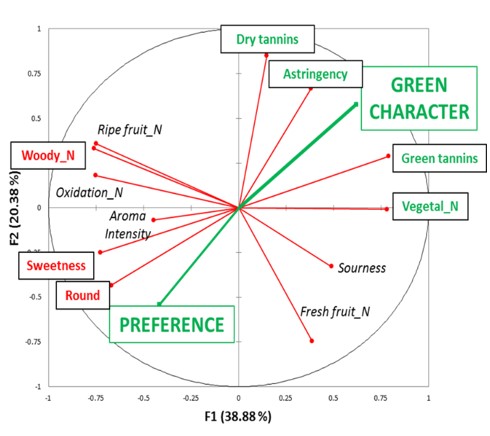
In this context, our work, focused on firstly defining the ill-defined term: green character, and then isolating and identifying the group of compounds (volatiles and non-volatiles) inducing such property. Finally, the real sensory implication, of these compounds or group of compounds, on the green character, was confirmed by spiking real wine samples. Thirty-eight wines with a priori different levels of green character, based on winemakers’ suggestions, were submitted to descriptive analysis by a panel of fifteen wine experts. Twelve descriptive attributes were rated on a five-point scale: six related to taste and mouthfeel properties (green tannin, dry tannin, astringency, sourness, sweetness and soft tannin) and six aroma-related (intensity, woody, vegetal, fresh fruit, ripe fruit and oxidation/reduction). Besides, two multidimensional terms, preference and green character, were also rated. Results showed that green character was a multidimensional term negatively correlated to preference and to woody aroma, sweetness and soft tannins, while positively to vegetal aroma, astringency, green and dry tannins (Figure 1).
Based on these results, for the study of sensory activity of non-volatile molecules, two wines with the highest scores in green character (W1 and W2) and other two with the lowest (W3 and W4) were selected. The non-volatile fraction of these four samples was fractionated by semipreparative liquid chromatography followed by solid-phase extraction. Six non-volatile fractions (Figure 2) were isolated for each wine and submitted to sensory characterization (together with the four selected wines) focused on taste and mouthfeel properties. Sixteen winemakers were provided with a list of 23 terms, which was previously generated in an intensive sensory work developed in a previous step. It consisted in a Rate-all-that-Apply (RATA) strategy as described in Sáenz-Navajas et al. 2017. That is, they had firstly to find the terms from the list that described the samples and only for those, rate the intensity in a seven-point-scale.
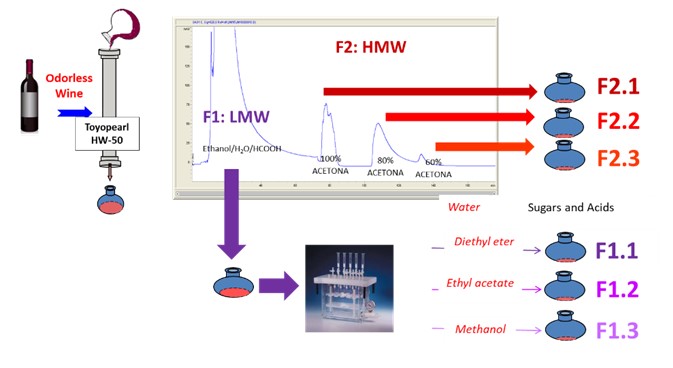
Based on the results of the descriptive analysis, for the study of sensory activity of volatile molecules, one wine with high (W5) and one (W6) with low vegetal aroma and green character were selected. The aroma extracts of both wines were fractionated by preparative liquid chromatography. The aroma properties of the 15 fractions obtained were classified by orthonasal evaluation employing a sorting task. However, no fraction with green-related aromas was found. Thus, another set of 16 wines were scored for green character. Quantitative characterization of sensory-active volatiles revealed that green wines were especially higher in isoamyl alcohol.
The sensory impact of the two non-volatile fractions (F13 and F22+F23) and volatile isoamyl alcohol on the green character was evaluated in two very different wines: a young (YW) and an oaked (OW) red wine. The wines, originally displaying no green character, were spiked with F22+F23, F13, isoamyl alcohol and submitted to sensory analysis by a panel of fifteen wine experts (Figure 3).
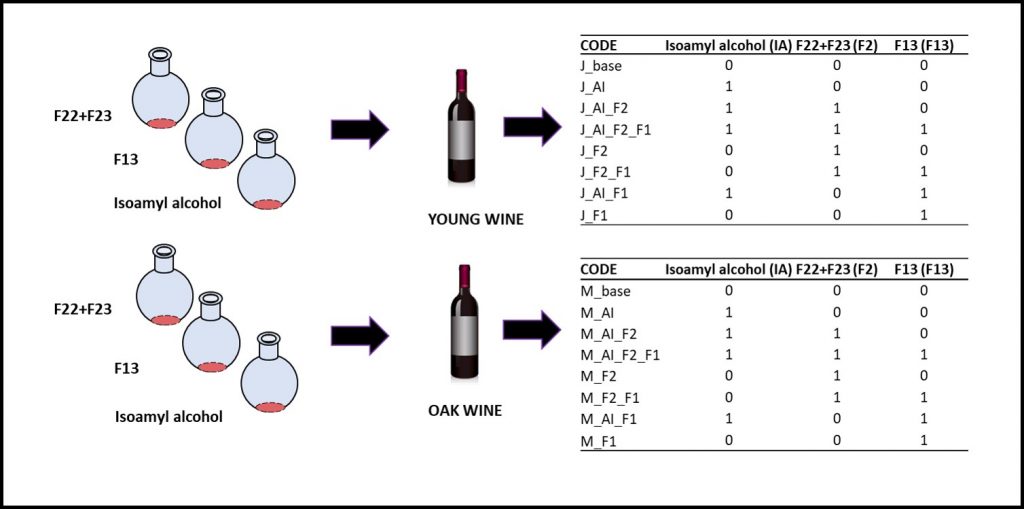
Interestingly, the single addition of isoamyl alcohol, proanthocyanidins (F22+F23) or anthocyanin-derivative compounds (F13) to a young or oaked aged red wine (base samples) does not generate a significant increase of the green character. However, the presence of isoamyl together with one of the two phenolic fractions significantly increase green character of wines. These results confirm that the interaction between isoamyl alcohol and the anthocyanin-derivative fraction and/or tannins is involved in the formation of green character in red wines by increasing astringent-related properties of wines. However, we were not able to find any volatile compound increasing the vegetal aroma of green wines. This result is very interesting firstly, because it shows that the volatile compound isoamyl alcohol, which has a spirit-like aroma can modulate mouthfeel properties and also because it confirms the mouthfeel properties elicited by anthocyanins, which was already observed in independent studies of our research group in Sáenz-Navajas et al. (2017) and of other groups by surface plasmon resonance (Guerreiro et al., 2017). Besides, results showed that young wines present significantly higher scores than oaked wines for green character. This result confirms that the green character is wine dependent and suggests that the oaked, ripe fruit and oxidation aromas of the oaked wine could mask green character.
Those interested in a longer length report can download the working paper at:
https://www.sciencedirect.com/science/article/pii/S0963996918303089
Institute of Grapevine and Wine Sciences (ICVV).
Oenology Research Group: Chemical and sensory analyses in enological research, Logroño, Spain.
The group studies the role of the aroma and the flavor of the wines. The research is carried out in collaboration with the Laboratory for Aroma Analysis and Enology (LAAE) from the University of Zaragoza. Understanding flavor and mouthfeel sensations are our main focus. We addressed this research by combining strategies of separation (chromatography), technologies of chemical elucidation (mass spectrometry) and organoleptic analysis (sensory analysis).
Research Group: Purificación Fernández Zurbano, María-Pilar Sáenz-Navajas, Marta Dizy Soto, José Federico Echávarri Granado, Sara Ferrero del Teso, Shu Yan Liu.
References:
- Ares, G., Bruzzone, F., Vidal, L., Cadena, R. S., Giménez, A., Pineau, B., Jaeger, S. R. (2014). Evaluation of a rating-based variant of check-all-that-apply questions: Rate-all-that-apply (RATA). Food Quality and Preference, 36, 87-95.
- De-La-Fuente-Blanco, A., Sáenz-Navajas, M. P., & Ferreira, V. (2016). On the effects of higher alcohols on red wine aroma. Food Chemistry, 210, 107-114.
- Ferreira, V., Hernández-Orte, P., Escudero, A., López, R., & Cacho, J. (1999). Semipreparative reversed-phase liquid chromatographic fractionation of aroma extracts from wine and other alcoholic beverages. Journal of Chromatography A, 864(1), 77-88.
- Gonzalo-Diago, A., Dizy, M., & Fernandez-Zurbano, P. (2013). Taste and Mouthfeel Properties of Red Wines Proanthocyanidins and Their Relation to the Chemical Composition. Journal of Agricultural and Food Chemistry, 61(37), 8861-8870.
- Gonzalo-Diago, A., Dizy, M., & Fernández-Zurbano, P. (2014). Contribution of low molecular weight phenols to bitter taste and mouthfeel properties in red wines. Food Chemistry, 154, 187-198.
- Guerreiro, J.R.L., Teixeira, N., De Freitas, V., Sales, M.G.F. , & Sutherland, D.S. A saliva molecular imprinted localized surface plasmon resonance biosensor for wine astringency estimation. Food Chemistry, 233, 457-466.
- Harbertson, J., Picciotto, E., & Adams, D. (2003). Measurement of polymeric pigments in grape berry extracts and wines using a protein precipitation assay combined with bisulfite bleaching. American Journal of Enology and Viticulture, 54(4), 301-306.
- Revelette, M. R., Barak, J. A., & Kennedy, J. A. (2014). High-performance liquid chromatography determination of red wine tannin stickiness. Journal of Agricultural and Food Chemistry, 62(28), 6626-6631.
- Sáenz-Navajas, M. P., Avizcuri, J. M., Ferrero-del-Teso, S., Valentin, D., Ferreira, V., & Fernández-Zurbano, P. (2017). Chemo-sensory characterization of fractions driving different mouthfeel properties in red wines. Food Research International, 94, 54-64.
- Sáenz-Navajas, M.P., Arias, I., Ferrero-del-Teso, S., Fernández-Zurbano, P., Escudero, A., Ferreira, V. (2018). Chemo-Sensory Approach for the Identification of Chemical Compounds Driving Green Character in Red Wines. Food Research International 109, 138–148.

